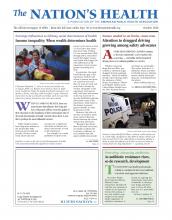Diabetes-related vision impairment is climbing worldwide, signaling a need for global health systems to make vision loss prevention a priority, according to a recent study.
The number of people who were visually impaired due to diabetic retinopathy increased by 64 percent globally from 1990 to 2010, according to research published in the September issue of Diabetes Care.
Diabetic retinopathy occurs when high blood glucose levels damage blood vessels in the retina of the eye. This can lead to difficulty in seeing and possibly blindness.
Researchers estimated global trends in diabetic retinopathy between 1990 and 2010 after analyzing over 240 studies worldwide on vision impairment and blindness.
Over 190 million people in 2010 were visually impaired, with 3.7 million diagnosed with diabetic retinopathy-related impairment. Blindness affected over 32 million people in 2010, with 800,000 blind due to diabetic retinopathy. But just as visual impairment from diabetic retinopathy increased 64 percent, so did blindness, by 27 percent between 1990 and 2010.
In addition, people were more likely to have visual impairment in countries in South Asia, the Middle East, North Africa and west Sub-Saharan Africa.
Blindness from diabetic retinopathy was more common in East Asia, tropical Latin America and south Sub-Saharan Africa.
The diversity between regions speaks to differences in access to primary care services, such as screenings, as well as socio-economic factors and ethnic differences in disease susceptibility, said Janet Leasher, OD, MPH, the lead study author and an associate professor of optometry at Nova Southeastern University’s College of Optometry.
While telemedicine practices, such as taking photos of the eye to send to health care professionals, can help expand health care to remote areas, they may not catch the subtleties of eye diseases an advanced exam can, Leasher said.
“Another thing is that a lot of people won’t seek out care if they don’t have symptoms,” Leasher told The Nation’s Health. “In the early stages of diabetic retinopathy, sometimes there are no symptoms. Sometimes the damage has already started to happen and is irreversible by the time they seek treatment. There may be cost issues or lack of insurance coverage, which of course is very difficult in many developing countries if it’s not included in the national health care system.”
Primary health care providers worldwide who are responsible for helping treat and manage their patients’ diabetes should integrate primary eye care education and refer patients for dilated eye exams, Leasher said. She cited the Vision 2020: The Right to Sight global initiative to eliminate avoidable blindness by 2020. The initiative, headed by the International Agency for the Prevention of Blindness and the World Health Organization, released a global action plan in 2013 to reduce preventable visual impairment by 25 percent by 2019.
For more information, visit http://care.diabetesjournals.org/content/39/9/1643
- Copyright The Nation’s Health, American Public Health Association









